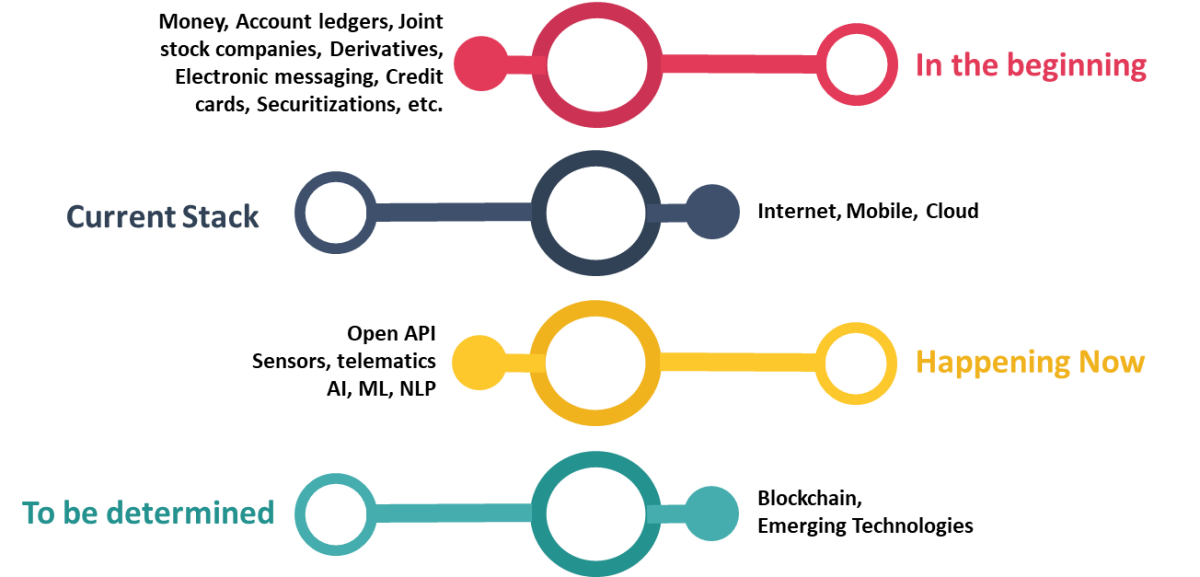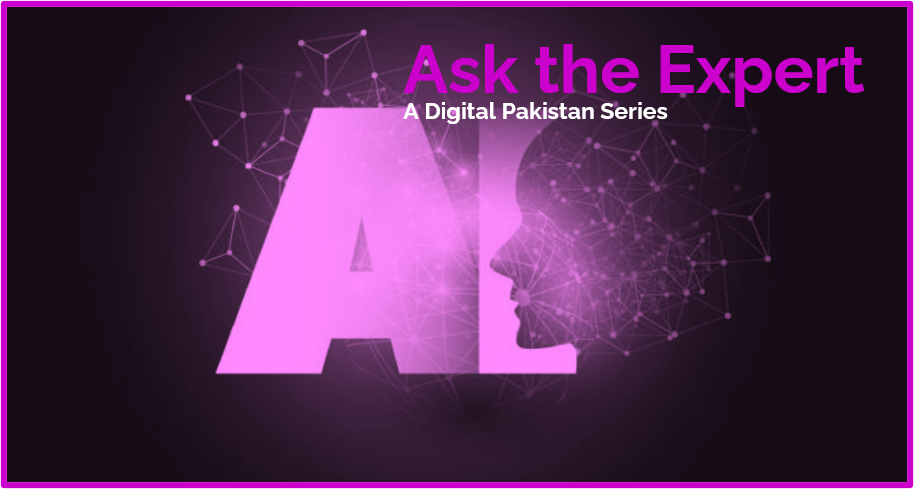
Communication as an Essential Service in Humanitarian Crises: Empowering Aid and Saving Lives
August 19, 2023
What if Pakistan became a Global Destination for Tourism?
August 21, 2023The Convergence of AI and Fintech
The modern fintech era was ignited by three pivotal advancements in the mid-1990s: the emergence of the internet, the ubiquity of mobile phones, and the power of cloud computing. It’s worth noting the synchronous founding of Amazon and eBay in 1995, swiftly followed by PayPal’s inception a year later. 1996 marked a significant milestone as the puzzle of securing commercial transactions online and cryptographically transmitting data packets fell into place. This breakthrough triggered a cascade of transformations that reverberated throughout the financial landscape, ushering in a new era of possibilities and innovation.

Figure 1 : Evolution of Financial Services
The Technology Stack
The current landscape of the fintech industry has brought the internet, mobile devices, and cloud computing to a baseline level, even for well-established players who may have been slower to embrace technology. The utilization of open APIs( Application Programming Interfaces) has granted third parties access to data that was traditionally held exclusively by major commercial banks. Concurrently, the realms of auto, health care, and property insurance markets are undergoing transformation through the integration of sensors and telematics.
The forthcoming wave of innovation over the next five to eight years will be propelled by AI, machine learning, and Natural Language Processing (NLP). These technologies are geared towards extracting and dissecting data from language-based sources such as white papers, earnings reports, press releases, and social media.
However, the role of blockchain, the distributed-ledger technology that underpins digital currencies like Bitcoin, remains a point of uncertainty. While the full extent of its integration is yet uncertain, blockchain undoubtedly serves as a catalyst for transformative change in the fintech landscape.

Figure 2 : FinTech Technology Stack
Role of AI in Fintech
Artificial Intelligent makes it possible to generate accurate insights related to customers and clients. This ultimately helps to reduce the time spent analyzing the huge amount of data. AI is programmed in a proficient way to tackle and manage daily based financial services.
Finance Management
Imagine having an AI-powered wallet that acts as your financial confidant, meticulously tracking every online transaction you make. This data is then subjected to sophisticated analysis, providing you with a clear and insightful spending graph. This graphical representation offers a visual depiction of your spending patterns, enabling you to identify trends, pinpoint areas of overspending, and make well-informed adjustments to your financial habits.
The brilliance of AI lies in its ability to not only provide raw data but to transform it into actionable insights. Through its analytical prowess, the AI-based wallet can suggest personalized budgeting strategies, offer expenditure forecasts, and even recommend optimized saving plans. It’s akin to having a financial advisor at your fingertips, available 24/7.
The accessibility and user-friendliness of AI-driven financial tools like these wallets cater to a broader audience, fostering financial literacy and responsible spending. As these technologies continue to evolve, we can expect even more sophisticated features, such as predictive spending alerts, investment recommendations, and integration with other financial instruments.
Risk Assessment
Consider a scenario where AI algorithms analyze customers’ historical loan repayment patterns, active loan portfolios, and credit card utilization. This in-depth scrutiny offers a nuanced understanding of individual financial behaviors, facilitating precise risk evaluation. By integrating AI into finance software, the accuracy of risk assessments is significantly enhanced, reducing the margin for errors and oversight.
The role of AI extends beyond accuracy. Automation, driven by AI’s smart and analytical capabilities, streamlines the risk assessment process. Mundane tasks that once required manual intervention can now be efficiently handled by AI systems. This not only expedites the assessment process but also frees up human resources for more strategic and complex decision-making tasks.
The convergence of AI and risk assessment not only optimizes the financial sector’s operations but also enhances customer experiences. Swift and accurate risk evaluations lead to quicker loan approvals and personalized financial services.
Financial Advisory
The emergence of AI-powered financial advisory services has ushered in a transformative era for the finance industry, characterized by both Robo and Bionic advisory solutions.
Robo advisory represents a paradigm shift in investment management. By leveraging advanced algorithms and data analytics, these platforms can provide precise and data-driven investment recommendations without the need for human intervention. The automation of routine tasks, coupled with real-time market insights, empowers investors with informed decision-making, ultimately optimizing portfolio performance.
Bionic advisory, on the other hand, takes this concept a step further by merging AI’s analytical prowess with human expertise. Financial institutions and organizations benefit from personalized services that seamlessly integrate the latest investment technologies. Bionic advisory platforms offer in-depth investment research, leveraging AI’s ability to process vast amounts of data to uncover hidden opportunities and risks.
Trading
The integration of AI technologies into trading and investment practices offers a plethora of benefits, from risk mitigation to informed decision-making. Through advanced machine learning algorithms, AI can analyze historical market data, identify patterns, and extrapolate future market movements. This foresight empowers institutions to take proactive measures, preventing financial crises and minimizing exposure to potential pitfalls.
AI’s real-time data analysis facilitates the determination of optimal trading moments. Imagine a scenario where AI analyzes a multitude of market indicators, news sentiments, and macroeconomic factors to ascertain the ideal time to buy, hold, or sell stocks. This data-driven decision-making ensures that trading actions are based on a comprehensive and holistic understanding of the market landscape, reducing the element of uncertainty.
AI-driven trading systems operate without emotional bias, a factor that often influences human traders. Rational decision-making, devoid of emotional fluctuations, can lead to more disciplined and consistent trading strategies. AI algorithms can swiftly process vast amounts of data and execute trades, enabling institutions to capitalize on fleeting opportunities that might escape human perception.
Personalized Services
Imagine a scenario where AI-driven systems assess an individual’s spending habits, investment history, and risk tolerance. Armed with this knowledge, the organization can offer finely tuned suggestions that optimize portfolio diversification, investment strategies, and risk management. This level of tailored guidance goes beyond generic advice, fostering a deeper sense of trust and engagement between the institution and the customer.
At the heart of this transformation lies the ability of AI to harness and analyze vast amounts of customer data from diverse sources. Through sophisticated algorithms, AI distills this data into meaningful patterns and trends, offering a comprehensive view of each customer’s financial landscape. This newfound understanding empowers organizations to provide personalized recommendations that align with their customers’ unique financial goals and preferences.
AI-generated insights are presented in a clear and comprehensible manner, ensuring that customers can make informed decisions with full awareness of the rationale behind the recommendations. This transparency not only enhances customer confidence but also encourages a collaborative and informed decision-making process..
Engaging Chatbots
Imagine a scenario where a customer has a question about their account balance or a recent transaction. Instead of waiting in a queue or navigating complex phone menus, they can simply interact with a chatbot. Using natural language processing, the chatbot understands the customer’s query and provides a precise and human-like response. This level of personalized assistance not only resolves customer inquiries promptly but also enhances their overall satisfaction.
The 24×7 availability of AI-driven chatbots can be a game-changer for bank service providers. Customers can access information, initiate transactions, or seek assistance at any time, irrespective of business hours. This heightened accessibility reflects a commitment to customer-centricity and convenience, reinforcing the bank’s dedication to meeting customer needs on their terms.
Fraud Detection
Picture a scenario where AI algorithms meticulously analyze vast streams of transactional data, swiftly identifying anomalies and patterns indicative of fraudulent behavior. These algorithms can detect irregularities that might escape human scrutiny, such as unusual purchasing patterns, unauthorized access attempts, or suspicious account activity. This level of precision enhances the organization’s ability to thwart fraud attempts in real time.
By continuously learning from historical data, AI systems can adapt to new and emerging fraud techniques, staying one step ahead of potential threats. This proactive approach ensures that fraudsters are met with a formidable defense mechanism, significantly reducing the window of opportunity for fraudulent activities.
One of AI’s strengths in combating fraud lies in its ability to manage and analyze uniquely identifiable information from customer transactions. Through sophisticated data analytics, AI can establish a baseline of normal behavior for each customer, enabling it to promptly detect deviations that may signal fraudulent actions. This dynamic approach allows financial institutions to tailor their responses to individual cases, minimizing false positives and optimizing the accuracy of fraud detection.
Cost Savings
By leveraging AI, banks can effectively manage time and resources, ensuring that routine and labor-intensive tasks are performed with precision and speed. Imagine a scenario where AI-powered systems handle data entry, transaction processing, and even basic customer inquiries. This liberates human resources from mundane tasks, allowing them to focus on more strategic and value-added activities that directly impact customer satisfaction and loyalty. This shift not only enhances employee engagement and job satisfaction but also elevates the organization’s ability to create tangible value for customers.
The infusion of AI-driven analytics into the finance process introduces new avenues for efficiency enhancement. AI can analyze vast amounts of data to identify operational bottlenecks, optimize resource allocation, and streamline workflow processes. This data-driven approach empowers organizations to make informed decisions that drive down costs while maintaining or even enhancing the quality of services provided.
Conclusion
The integration of AI-driven solutions, from predictive analytics and personalized customer experiences to fraud detection and cost-cutting measures, has reshaped the way financial services are delivered and experienced. The journey ahead promises a continued fusion of human expertise and technological prowess, creating a dynamic ecosystem that not only enhances operational efficiency but also empowers individuals and businesses to navigate the ever-evolving financial terrain with confidence and agility. The role of AI in fintech is not just a technological advancement; it’s a paradigm shift that holds the promise of a more accessible, efficient, and customer-centric financial future.
About the writer: Dr. Usman Zia is an Assistant Professor at the School of Interdisciplinary Engineering and Sciences, National University of Sciences and Technology (NUST), Pakistan. His research interests are Natural Language Processing and Machine Learning. He has authored numerous publications on language generation and machine learning. As an AI enthusiast, he is actively involved in a number of projects related to generative AI and NLP.






